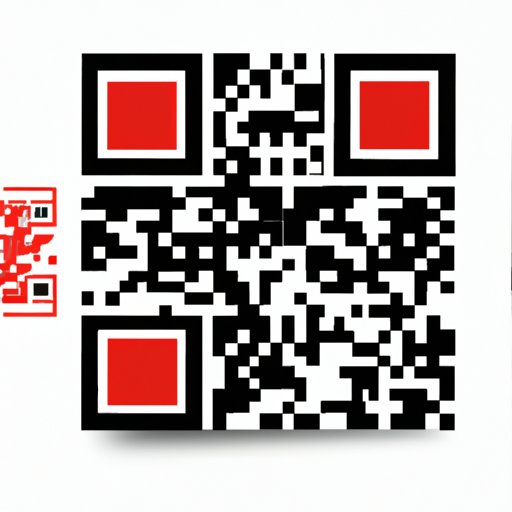
Introduction
QR codes, or Quick Response codes, were first developed in Japan in 1994 for the automotive industry. Today, they have expanded to a wide range of industries and uses, from advertising and marketing to accessing information and making contactless payments. This article aims to provide a comprehensive guide on QR codes and their various uses for both personal and business purposes.
A Step-by-Step Guide on How to Scan a QR Code Using a Smartphone Camera
Most smartphones today have a built-in camera that can scan QR codes. To scan a QR code using your smartphone camera:
- Open the camera app on your smartphone
- Point the camera at the QR code and make sure it’s within the camera frame
- Wait for your smartphone to recognize the QR code and offer a link or request further action from you
- If nothing happens, try adjusting the lighting or positioning of your smartphone to get a better scan
It’s important to note that some older smartphones may not support QR code scanning, in which case you can download a QR code scanning app from your app store. Additionally, if you’re having trouble scanning the code, try moving the code closer or further away from the camera to find the right distance.
A Comparison of Different QR Code Generator Tools Available Online
Several QR code generator tools are available online, both free and paid. These tools offer a wide range of features and benefits, some of which include:
- Customization options
- Scalability
- Analytics and tracking
- Marketing and advertising integrations
Some of the most popular QR code generator tools include:
- QR Code Generator
- QR Stuff
- Scanova
- Visualead
When selecting a QR code generator tool, it’s important to consider your specific needs, as each tool has unique features and pricing models. Scanova, for example, offers dynamic QR codes that can be edited even after they are published, which is a useful feature for businesses that need to update their information frequently.
An Article on the Benefits and Use Cases of QR Codes for Businesses
QR codes can be an effective tool for businesses to engage customers and drive sales. The different types of QR codes that businesses can use include:
- URL codes that take customers to a specific website or landing page
- Contact codes that make it easy for customers to add contact information to their phone
- Event codes that enable customers to register for an event or sign up for a newsletter
- Payment codes that enable customers to make contactless payments at a store or restaurant
One of the key benefits of QR codes for businesses is the ability to track metrics and analyze engagement. Google Analytics, for example, can be integrated with QR codes to track clicks and conversions.
To create a QR code for a business, follow these steps:
- Select the type of QR code you want to create
- Enter the relevant information, such as a URL or contact information
- Customize the code with logos, images, and colors if desired
- Publish the code and track engagement
Successful QR code campaigns include calls to action and incentives for customers to scan the code, such as a discount or exclusive content.
A Tutorial on How to Design Your Own Custom QR Codes
Designing a QR code that reflects your brand’s image can make it more attractive and engaging to customers. Here are some tips for creating custom QR codes:
- Choose an appropriate color scheme that reflects your brand
- Incorporate images or logos into the QR code
- Test the QR code to ensure it’s still scannable after customization
Examples of effectively designed custom QR codes include codes that incorporate a brand’s logo, color scheme, and product images. For example, a food manufacturer could create a QR code that includes images of their products and a call to action to visit their website for recipes and cooking tips.
An Article on Some of the Best Use Cases for QR Codes in Everyday Life
QR codes can be used in a wide range of everyday situations, from making payments to accessing important personal information. Here are some innovative ways to use QR codes:
- Pay for goods and services with contactless payment QR codes
- Check in to events or flights with event QR codes
- Access medical information in case of emergency with medical QR codes
- Store and display contact information with contact QR codes
QR codes can also be used in retail stores to offer customers product information, reviews, and coupons. Additionally, museums and tourist attractions can use QR codes to provide visitors with detailed information about exhibits and landmarks.
A Guide on How to Troubleshoot Issues with Scanning QR Codes
While QR codes are generally easy to scan, there are some common issues that can prevent a successful scan. Some tips for troubleshooting scanning issues include:
- Adjusting the phone’s brightness and/or positioning to achieve the best angle for scanning
- Checking to ensure the QR code is not copied or saved as a lower-quality image
- Restarting the phone to resolve any temporary software issues
If issues persist, users should try scanning the code with a different app or device. If all else fails, users can contact the QR code provider for additional assistance.
Conclusion
QR codes are a versatile and convenient tool for both personal and business purposes. From scanning to creating and troubleshooting, this complete guide has covered everything you need to know to make the most of QR codes in your daily life. The key takeaway is to experiment with QR codes and explore all the innovative ways they can be used to simplify tasks and enhance engagement.





